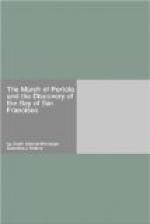It must be understood that the marches of these troops with such a train through an unknown country and by unused paths, could not be long ones. It was necessary to explore the land one day for the march of the next, and the camp for the day was sometimes regulated by the distance to be traveled to the next place where water, fuel, and pastures could be had. The distance made was from two to four leagues[18], and the command rested every four days, more or less, according to the fatigue caused by the roughness of the road, the toil of the pioneers, the wandering off of the beasts, or the necessities of the sick. Costanso says that one of their greatest difficulties was in the control of their caballada (horse-herd), without which the journey could not be made. In a country they do not know, horses frighten themselves by night in the most incredible manner. To stampede them, it is enough for them to discover a coyote or fox. The flight of a bird, the dust flung by the wind-any of these are capable of terrifying them and causing them to run many leagues, precipitating themselves over barrancas and precipices, without any human effort availing to restrain them. Afterwards it costs immense toil to gather them again, and those that are not killed or crippled, remain of no service for some time. In the form and manner stated, the Spaniards made their marches, traversing immense lands, which grew more fertile and pleasing as they progressed northward.
The expedition followed practically the route which afterwards became the Camino Real. Its fourth jornada (day’s journey) brought it to the pretty valley where later was established the mission of San Luis Rey. They called it San Juan Capistrano, but that name was afterwards transferred to a mission forty miles north of this place. The command rested here, July 19th. Resuming the march on the 20th, the sierra (San Onofre), whose base they were skirting, drew so near the sea that it seemed to threaten their advance, but by keeping close to the shore, they held their way, and on the 24th they encamped on a fine stream of water running through




